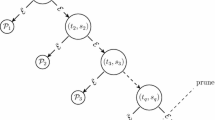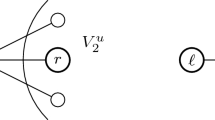Abstract—
This article considers the concept of a linear separation direct algorithm introduced by V.A. Bondarenko in 1983. The concept of a direct algorithm is defined using the solution graph of a combinatorial optimization problem. The vertices of this graph are all feasible solutions of the problem. Two solutions are called adjacent if there are input data for which these and only these solutions are optimal. A key feature of direct algorithms is that their complexity is bounded from below by the clique number of the solution graph. In 2015–2018, there were five articles published, the main results of which are estimates of the clique numbers of polyhedron graphs associated with various combinatorial optimization problems. The thesis that the class of direct algorithms is broad and includes many classical combinatorial algorithms, including the branch-and-bound algorithm for the traveling salesman problem proposed by J.D.C. Little, K.G. Murty, D.W. Sweeney, and C. Karel in 1963, was the main motivation for these articles. We show that this algorithm is not a direct algorithm. Earlier, in 2014, the author of this article showed that the Hungarian algorithm for the assignment problem is not a direct algorithm. Therefore, the class of direct algorithms is not as broad as previously assumed.

Similar content being viewed by others
Notes
But no source references with corresponding proofs were given.
Elements of the matrix can always be written out in a row or a column.
REFERENCES
Bondarenko, V., Nikolaev, A., and Shovgenov, D., 1-skeletons of the spanning tree problems with additional constraints, Autom. Control Comput. Sci., 2017, vol. 51, no. 7, pp. 682–688. https://doi.org/10.3103/S0146411617070033
Bondarenko, V. and Nikolaev, A., On graphs of the cone decompositions for the min-cut and max-cut problems, Int. J. Math. Math. Sci., 2016, vol. 2016, p. 7863650. https://doi.org/10.1155/2016/7863650
Bondarenko, V. and Nikolaev, A., Some properties of the skeleton of the pyramidal tours polytope, Electron. Notes Discrete Math., 2017, vol. 61, pp. 131–137. https://doi.org/10.1016/j.endm.2017.06.030
Bondarenko, V.A., Nikolaev, A.V., and Shovgenov, D.A., Polyhedral characteristics of balanced and unbalanced bipartite subgraph problems, Autom. Control Comput. Sci., 2017, vol. 51, no. 7, pp. 576–585. https://doi.org/10.3103/S0146411617070276
Bondarenko, V.A. and Nikolaev, A.V., On the skeleton of the polytope of pyramidal tours, J. Appl. Ind. Math., 2018, vol. 12, no. 1, pp. 9–18. https://doi.org/10.1134/S1990478918010027
Bondarenko, V.A., Nonpolynomial lowerbound of the traveling salesman problem complexity in one class of algorithms, Autom. Remote Control, 1983, vol. 44, no. 9, pp. 1137–1142.
Bondarenko, V., Geometrical methods of systems analysis in combinatorial optimization, Doctor Sci. (Phys.-Math.) Dissertation, Yaroslavl’: Demidov Yaroslavl State Univ., 1993.
Bondarenko, V. and Maksimenko, A., Geometricheskie konstruktsii i slozhnost’ v kombinatornoi optimizatsii (Geometric Structures and Complexity in Combinatorial Optimization), Moscow: URSS, 2008.
Maksimenko, A.N., Characteristics of complexity: clique number of a polytope graph and rectangle covering number, Mod. Anal. Inf. Sist., 2014, vol. 21, no. 5, pp. 116–130.
Little, J.D.C., Murty, K.G., Sweeney, D.W., and Karel, C., An algorithm for the traveling salesman problem, Oper. Res., 1963, vol. 11, no. 6, pp. 972–989.
Reingold, E., Nievergelt, J., and Deo, N., Combinatorial Algorithms: Theory and Practice, Prentice Hall College Div., 1977.
Padberg, M.W. and Rao, M.R., The travelling salesman problem and a class of polyhedra of diameter two, Math. Program., 1974, vol. 7, no. 1, pp. 32–45. https://doi.org/10.1007/BF01585502
Author information
Authors and Affiliations
Corresponding author
Ethics declarations
The author declares that he has no conflicts of interest.
Additional information
Translated by O. Pismenov
About this article
Cite this article
Maksimenko, A.N. The Branch-and-Bound Algorithm for the Traveling Salesman Problem is Not a Direct Algorithm. Aut. Control Comp. Sci. 55, 816–826 (2021). https://doi.org/10.3103/S0146411621070269
Received:
Revised:
Accepted:
Published:
Issue Date:
DOI: https://doi.org/10.3103/S0146411621070269




